Are you a Quiet Speculation member?
If not, now is a perfect time to join up! Our powerful tools, breaking-news analysis, and exclusive Discord channel will make sure you stay up to date and ahead of the curve.
Nearly there! Welcome to the penultimate entry in the deck guides. Next week I'll finish up with the remaining deck types and we'll finally be done with all the archetypes of Modern! Then I'll finally be free to write about other, more topical things again.
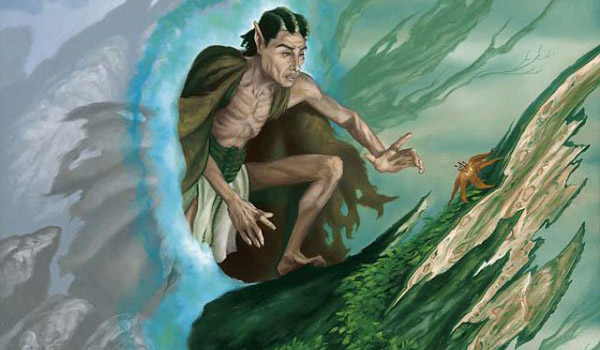
Ramp decks occupy a weird place in Magic. Arguably the oldest archetype, they're also one of the most divisive. On the one hand Ramp has been incredibly powerful throughout Magic's history. On the other it is the most likely to be dismissed as the "little kid" deck. I don't fully understand this attitude. Yes, it is likely to appeal to younger players, but it has such a long history that the assumption becomes ludicrous. These are powerful, dangerous decks and to dismiss them is deadly.
Oddly, Standard players may not be familiar with Ramp. Despite its very long history and arguably being a core strategy of the game, you just don't see ramp spells in Standard very much anymore. It used to be the key feature of green, but Wizards has decided to severely cut back on ramp in recent years. There were a few Ramp decks during Dragons of Tarkir-Battle for Zendikar Standard, but that was an anomaly compared to Standards before and since. I don't really get the reasoning, but at this point it's far more noticeable when Ramp is viable than when it isn't. As a result players generally think that Ramp is just about dropping bombs until the opponent dies. It does do that, but that isn't actually the defining feature of the strategy.
[wp_ad_camp_1]
What Are Ramp Decks?
At their core, Ramp decks generate a tremendous, mostly permanent, mana advantage which they leverage to kill the opponent. Yes, that mostly takes the form of just dropping huge bombs, but it doesn't have to. The defining feature is mana, not spells. You use accelerants to generate a crushing board position before your opponent is able to react.
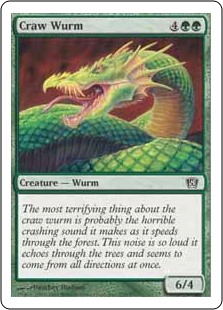 Ramp has existed from the beginning of the game, when Timmy first realized that Wild Growth let him play Craw Wurm a turn earlier. He then took it to the logical extreme when he made a deck entirely of Black Lotuses and Wurms so he could do it all on turn one. And lose all his friends. Which is why we have the DCI today. Anyway, back on topic, all Ramp decks since the beginning have looked to build their mana to ridiculous levels as quickly as possible and then use that advantage to drop more powerful win conditions earlier than their opponent and ride that to victory. Simple and straightforward.
Ramp has existed from the beginning of the game, when Timmy first realized that Wild Growth let him play Craw Wurm a turn earlier. He then took it to the logical extreme when he made a deck entirely of Black Lotuses and Wurms so he could do it all on turn one. And lose all his friends. Which is why we have the DCI today. Anyway, back on topic, all Ramp decks since the beginning have looked to build their mana to ridiculous levels as quickly as possible and then use that advantage to drop more powerful win conditions earlier than their opponent and ride that to victory. Simple and straightforward.
Despite what it sounds like, you don't actually have to play land ramp spells to count as a Ramp deck. In fact, most of the really famous ones don't. You see, the mana advantage you are generating doesn't have to come from your lands. The most powerful Ramp spell ever printed is Tinker because it allows you to cheat on mana to accelerate out a gigantic threat. I realize that this sounds a lot like unfair combo decks but the difference is that the mana an unfair combo generates is temporary to produce an instant win where Ramp's advantage is turned into permanents. The mana advantage doesn't have to be permanent as well.
The presence of mana accelerants does not qualify a deck as Ramp. Mana is the fundamental resource of Magic and if you can accelerate, it is normally correct to do so. Ramp decks are defined by being built around acceleration rather than taking advantage of it. If the deck is decent when it has to play fair with its mana it doesn't qualify as Ramp. Ramp decks have to accelerate to be good. Most decks in these archetypes have worked fairly similarly so I could write about them as a group, but Modern's Ramp decks are not exactly traditional and are wildly different from each other. Ergo, I'll be dealing with them separately.
Tron
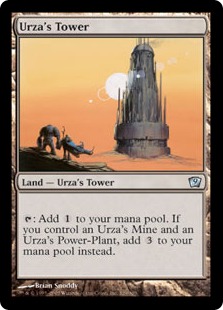 Tron is the most common Ramp deck in Modern, largely due to its simplicity and power. There are a number of variants, but they share the same gameplan. It doesn't play any kind of mana accelerants, it doesn't require complex thought or strategy. You simply assemble the Urzatron and you win. The Urzatron, for this series' intended audience, is the name given to the three Urza lands (Urza's Tower, Powerplant, and Mine) that when you have in play generate seven mana. You then use this to play very large colorless spells and you usually win when your opponent concedes in frustration.
Tron is the most common Ramp deck in Modern, largely due to its simplicity and power. There are a number of variants, but they share the same gameplan. It doesn't play any kind of mana accelerants, it doesn't require complex thought or strategy. You simply assemble the Urzatron and you win. The Urzatron, for this series' intended audience, is the name given to the three Urza lands (Urza's Tower, Powerplant, and Mine) that when you have in play generate seven mana. You then use this to play very large colorless spells and you usually win when your opponent concedes in frustration.
Tron is unique because its acceleration comes from its lands. Most Ramp decks have to play spells that let them play extra lands to build their advantage. As a result Tron decks play lots of cantrips and land search rather than acceleration. The goal is to play the right lands, not the most.
Valakut
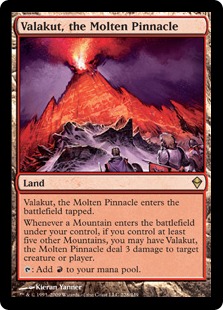 There are a number of different Ramp decks based around Valakut, the Molten Pinnacle, the differences between decks largely determined by their speed and whether they have interaction. While many do run Scapeshift, they are not Scapeshift combo decks. The combo version relies on Scapeshift to actually activate and win with Valakut, while the Ramp decks do not. These decks are fully capable of activating Valakut the way it was intended. They do run Scapeshift as an easy route to victory, but it just complements the gameplan. These are traditional Ramp decks, containing lots of land acceleration such as Explore and Sakura-Tribe Elder. Where Tron is looking to play the right three lands, Valakut decks seek to play five Mountains and a Valakut to turn every subsequent land drop into a Lightning Bolt. Combine with the signature Ramp card Primeval Titan to quickly crush the opponent.
There are a number of different Ramp decks based around Valakut, the Molten Pinnacle, the differences between decks largely determined by their speed and whether they have interaction. While many do run Scapeshift, they are not Scapeshift combo decks. The combo version relies on Scapeshift to actually activate and win with Valakut, while the Ramp decks do not. These decks are fully capable of activating Valakut the way it was intended. They do run Scapeshift as an easy route to victory, but it just complements the gameplan. These are traditional Ramp decks, containing lots of land acceleration such as Explore and Sakura-Tribe Elder. Where Tron is looking to play the right three lands, Valakut decks seek to play five Mountains and a Valakut to turn every subsequent land drop into a Lightning Bolt. Combine with the signature Ramp card Primeval Titan to quickly crush the opponent.
I do realize that there are additional Ramp decks out there, like Tooth and Nail and Nykthos Green. However, I have yet to see any evidence that such decks are viable enough to consider playing them over these two categories. They aren't viable enough to include. As for Amulet Titan, I don't consider it to be a Ramp deck—it attempts to break a number of fundamental rules, and is better classified under unfair combo.
Strengths and Weaknesses
There is less overlap between the two types than you may think. However, there are a few traits that all Ramp decks have in common.
First and foremost, all Ramp decks are masters of defeating Fair decks. If you're trying to grind incremental advantage, you dread the Ramp matchup. First, Ramp decks don't play many cards that can be easily interacted with. The Fair decks simply aren't equipped to deal with the kinds of threats that Ramp deploys. Ramp threats are capable of ending the game on their own in very few turns. There isn't time to grind advantage against them while their mana advantage is producing overwhelming threats. This places Fair decks in a situation where they are constantly behind Ramp's threats and if they don't have exactly the right answers at the right time they will lose. Unlike aggressive decks, Fair decks cannot consistently establish early clocks well enough to shift the clock in their favor. Every turn, Ramp's mana advantage grows until it wrecks you, and Fair decks struggle to prevent this from happening.
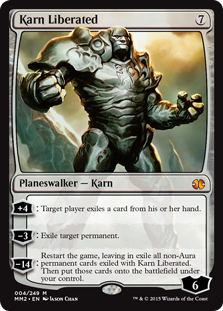 Secondly, Ramp decks get free wins. They play some of the most powerful bombs in the room and they're not easy to stop. As a result they crush the unprepared. Further, a well-constructed Ramp deck is fully capable of "getting there" even in the face of disruption. These decks have a lot of redundancy and if you give them an opening they can win seemingly out of nowhere. There's a lot to be said for just dropping bombs until something hits.
Secondly, Ramp decks get free wins. They play some of the most powerful bombs in the room and they're not easy to stop. As a result they crush the unprepared. Further, a well-constructed Ramp deck is fully capable of "getting there" even in the face of disruption. These decks have a lot of redundancy and if you give them an opening they can win seemingly out of nowhere. There's a lot to be said for just dropping bombs until something hits.
The most important weakness of all Ramp decks is their lack of business spells. These decks have a relatively high likelihood of doing nothing in a game. They're not quite the kings of durdle, but they're close. Ramp, by necessity, is primarily made of lands and cards that help you find and/or play lands. This is less burdensome for Valakut, but the problem remains: you may get your mana perfectly but fail to actually do anything. It's the risk you take to play the big spells.
Another thing to note is that none of these decks are very good against unfair combos or Gotcha! decks. They cannot spare the space for much interaction and thus are at risk of decks just going over them. If you can race or ignore them, ramp decks are nearly powerless against you.
Now, as for the unique aspects:
Tron
Tron has spent most of Modern's history as the sole Ramp deck, and it maintains the crown for good reason. This traditional RG version is a nightmare for BGx. Recent GB and GW variants, while a little less potent against BGx, are better against a number of normally poor matchups. The deck is capable of assembling Tron on turn three consistently and simply crushing opponents. Rather than play actual mana acceleration, the deck uses consistency tools, cantrip artifacts and Ancient Stirrings to find its  lands. This has the bonus effect of reducing the risk of never drawing threats. You simply cantrip more than other decks. This consistency and redundancy are its greatest strengths. Furthermore, it plays far more powerful threats than any other deck. This power can be enough to simply overwhelm opponents. Ugin, the Spirit Dragon simply beats aggressive decks.
lands. This has the bonus effect of reducing the risk of never drawing threats. You simply cantrip more than other decks. This consistency and redundancy are its greatest strengths. Furthermore, it plays far more powerful threats than any other deck. This power can be enough to simply overwhelm opponents. Ugin, the Spirit Dragon simply beats aggressive decks.
The main weakness of Tron is that it has been around for so long that everyone knows it and has a plan to beat it. This is the price you pay for success. However, this isn't the only problem. Tron is slow. Tron may accelerate out its threats quickly, but unless that threat is Wurmcoil Engine, you don't actually win the game very quickly. A turn-three Karn may be devastating, but he won't actually end the game for quite a while. If the early threat is not impactful enough, Tron might fail to win. It's weird to say, but sometimes Tron's threats are its Achilles Heel. They generate overwhelming advantage quickly, but if the opponent keeps fighting they can be overcome. Tron wins far more games off of frustrated concessions than it does actually killing the opponent, which is fortunate because sometimes it can't.
Valakut
All Ramp decks are hard to interact with for most decks, but Valakut is an extreme case. The deck wins with lands and can ignore most forms of disruption. As a result it can simply power through many decks. Tron has some vulnerability to discard and counterspells, but Valakut 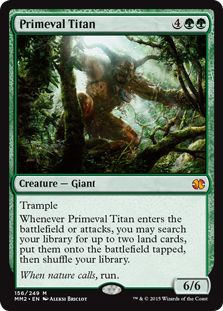 cannot be Thoughtseized or countered. Its matchup against slow decks is much better as a result.
cannot be Thoughtseized or countered. Its matchup against slow decks is much better as a result.
The other great strength of these decks are speed. Valakut decks are fully capable of winning on turn four, either through Scapeshift or Primeval Titan. This means that they're far less vulnerable to being raced by unfair combo than Tron.
However, Valakut decks are also at higher risk of doing nothing than Tron. They're great at finding Mountains, less good at finding actual cards that matter. Without Tron's sea of cantrips there's no guarantee you'll see business spells or Valakut. This gives the deck a higher fail rate than Tron. It is also far more all-in on Valakut than Tron is on its threats. As a result, if it is answered there may be no recovery.
Dropping the Bombs
The key to these decks is finding their mana. You do nothing unless you are accelerating something out, so don't keep a hand unless it promises to do that. Hands that are just enablers need to have a payoff card to be keepable. You'll keep any hand that actually generates your mana advantage quickly enough, but you may need to sequence your enablers to maximize your chance of actually doing something. Keeping a disruption-heavy hand can be acceptable, such as in Tron with multiple Oblivion Stones, but it is risky. If your hand needs more than two key cards to do something, you need to ship the hand.
The other overlooked skill is recognizing which powerful thing you need to do when. You may have multiple payoff cards in hand and you need to know, based on the situation, which bomb is most powerful. You have to maximize the impact of each spell because you don't play many. If you mis-sequence you'll give the opponent a chance to recover and answer you—if that happens enough, you'll have nothing left. You're hard to answer, not impossible. Recognize this and prepare accordingly.
Beating Ramp
It appears obvious that land destruction and mana denial are effective against Ramp, but it isn't quite that simple. These decks play a lot of lands. You can buy yourself time by stalling their development, but they will get there eventually. You need more of a plan.
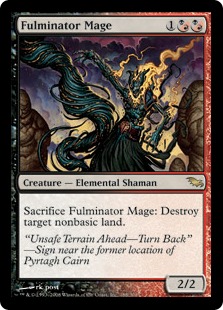 Mana disruption cannot win the game, just buy you a few extra turns. As a result, racing is very effective. These decks aren't always able to stop you from just killing them (which is why Tron decks are going for black and white interaction these days). Aggro decks that pack Ghost Quarter are a nightmare for Tron. Similarly, if you can just ignore their powerful threats you can just win anyway.
Mana disruption cannot win the game, just buy you a few extra turns. As a result, racing is very effective. These decks aren't always able to stop you from just killing them (which is why Tron decks are going for black and white interaction these days). Aggro decks that pack Ghost Quarter are a nightmare for Tron. Similarly, if you can just ignore their powerful threats you can just win anyway.
Another, riskier, method is to just answer all the bombs. As I've said, Ramp doesn't play a lot of actual spells. If you are able to counter or remove their initial few threats, you may win by default. Hard counters are very powerful against Ramp for this reason. The problem is that they can more easily play multiple bombs in a turn than can be answered thanks to their mana advantage. If anything gets through, it's probably game over.
Tron
It was traditionally thought that Blood Moon was game over against Tron, but it isn't. Tron is fully capable of just playing enough lands to cast all its colorless threats. If you don't present a clock, Tron will always win. However, Tron is in many ways a combo deck and if you can take out part of that combo then the deck starts to flounder. Sowing Salt is incredibly powerful against Tron. The deck may never miss a land drop, but when it doesn't get to drop a bomb early it just isn't very impressive. There's a reason that Karn Liberated only sees play when he can be cast on turn three. Tron can also be ignored more easily than Valakut, which is why Burn has always been a problem for the deck.
Tron also has an unusual weakness to Stony Silence and Pithing Needle. The deck relies on artifacts with activated abilities and planeswalkers. If you can stop those then the deck grinds to a halt. The best strategy I've found against Tron is to just play an aggressive deck and have some Ghost Quarters. You only have to slow them down a little for your clock to beat theirs, and Tron doesn't like to react. It wants to sail past like a majestic battlecruiser, not fend off swarms of flies.
Valakut
 You'd think that Blood Moon would be worse here, but it isn't. If Valakut doesn't have a text box, these decks really struggle to win. In fact, many only have Valakut and Primeval Titan as win conditions. If you can prevent either from connecting, you will win. Counters and discard, the traditional forms of interaction, are much more potent here as a result. Creature swarms still work, but these decks tend to run Anger of the Gods. As a result, it is harder to ignore Valakut decks and just race. You need to pack some disruption.
You'd think that Blood Moon would be worse here, but it isn't. If Valakut doesn't have a text box, these decks really struggle to win. In fact, many only have Valakut and Primeval Titan as win conditions. If you can prevent either from connecting, you will win. Counters and discard, the traditional forms of interaction, are much more potent here as a result. Creature swarms still work, but these decks tend to run Anger of the Gods. As a result, it is harder to ignore Valakut decks and just race. You need to pack some disruption.
Valakut is also weak to a number of common anti-combo cards. Leyline of Sanctity prevents Valakut from killing you, as does Runed Halo. Valakut is at far greater risk of being shut out of its win conditions than Tron, so that is a very viable strategy.
Ramp it Up
Ramp is very powerful, but that power comes at the risk of doing nothing. It can crush you before you can react, but it is also at risk of being locked out of winning. If you're going to pick this strategy up, understand the risks. But don't forget to reap the reward. Playing really big threats early really is as fun as Timmy says.





As a beginner I found the article very helpful. Great job!
Titan amulet is not a ramp deck? It runs 27 lands, 8 cantrips to find lands, 8 creatures to get more landdrops and 4 creatures that put lands into play.
All true. The line I’m drawing is what it does with those lands and how it actually operates. When Amulet is just playing like a ramp deck it isn’t impressive. It’s when you are using karoos to generate absurd mana that the deck actually shines. Because of how reliant it is on exploiting the karoos and Amulet I think it is really a combo deck, and an unfair one at that.